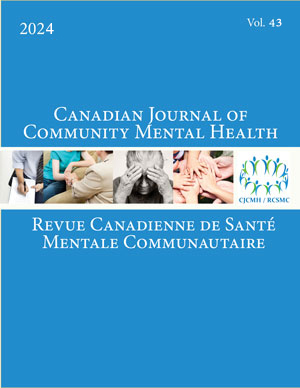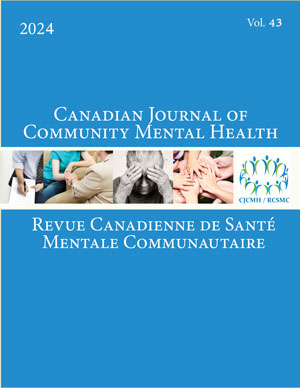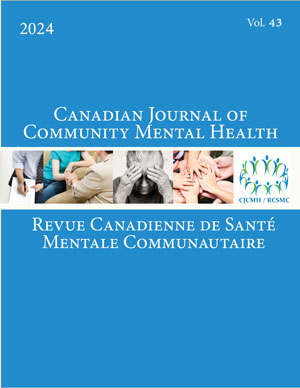Volume 28 • Number 1 • April 2009
OPEN ACCESS
The purpose of this study was to gain a better understanding of the association between youth substance use patterns and mental health symptoms, and the risk and protective factors unique and common to each of these areas. A survey was administered to a random sample of 663 youth ages 12 to 18 in Victoria, British Columbia. As expected, age was a strong predictor of greater frequency and amounts of alcohol consumption. Males were at higher risk for alcohol consumption and externalizing problems while females were more susceptible to internalizing problems. Youth who scored lower on substance use and reported fewer mental health symptoms rated their parents and peers as being more protective. Youth who scored higher on substance use scored higher on the risky peer affiliations scale.
OPEN ACCESS
Cette étude qualitative explore les points de vue d'intervenantes et intervenants psychosociaux concernant l'aliénation parentale (AP), une problématique qui renvoie aux situations où un enfant rejette l'un de ses parents sous l'influence de son autre parent. Les participants et participantes sont des intervenants et intervenantes provenant d'organismes communautaires et d'établissements du réseau de la santé et des services sociaux œuvrant auprès de femmes, d'hommes, d'enfants et de familles. Quatre groupes focalisés ont été animés selon une méthode semi-structurée pour une durée approximative de 2 heures. Les résultats indiquent que tous les intervenants et intervenantes reconnaissent l'existence du phénomène de l'AP. De plus, il y a plus de convergences qu'attendu dans les discours des différents groupes rencontrés. Aussi, chaque groupe d'intervenants et intervenantes contribue à la compréhension d'une facette importante de l'AP. Ces résultats commandent l'émergence de recherches futures plus spécifiques qui pourraient permettre de mieux comprendre et connaître l'AP. Il serait alors possible d'aider les familles concernées par ce problème à l'aide d'interventions davantage adaptées à leurs besoins.
OPEN ACCESS
Cette étude décrit un service de parrainage téléphonique destiné aux personnes qui ont été conduites à l'urgence d'un hôpital suite à un appel de détresse logé sur la ligne d'intervention téléphonique d'un centre de prévention du suicide. Quelques jours après l'envoi de secours, un intervenant ou une intervenante d'expérience du centre de prévention du suicide rappelle ces personnes, sans qu'elles n'en aient fait la demande, afin d'évaluer leur situation et leur offrir du soutien téléphonique. Une évaluation du processus est réalisée à partir d'une analyse des informations disponibles dans les dossiers et d'entrevues réalisées auprès d'un échantillon consécutif de 16 usagers et usagères. L'étude révèle que le service rejoint la clientèle ciblée et que l'aspect proactif du service de même que la qualité de la relation établie avec l'intervenant ou l'intervenante sont les caractéristiques les plus fortement appréciées. Les résultats suggèrent qu'il peut s'avérer profitable d'adopter la politique de la main tendue auprès d'une clientèle à haut risque de suicide.
OPEN ACCESS
Mental Illness and Police Interactions in a Mid-Sized Canadian City: What the Data Do and Do Not Say
This study examines the quantity and nature of police interactions for people with mental illness in London, Ontario, Canada, in 2001. An algorithm designed for a police services administrative database was used to identify 817 people with mental illness and 111,095 people without mental illness. Charges and arrests were examined using 100 randomly selected records. People with mental illness had 3.1 more police interactions on average than the general population, and they were more frequently charged and arrested. As police officers became more familiar with the individuals, they were not much more likely to identify them as violent even when a person with mental illness had been a violent perpetrator.
OPEN ACCESS
Cet article relate les principaux résultats d'une recherche effectuée auprès d'orphelins rescapés du génocide des Tutsis du Rwanda qui sont devenus responsables d'eux-mêmes après 1994. Le but de cette étude était de comprendre les facteurs de protection qui ont permis à certaines et certains d'entre eux de survivre dans leurs ménages et en même temps de poursuivre leurs études jusqu'à l'université malgré de multiples facteurs de risque auxquels ils ont été confrontés durant et après le génocide. Ces facteurs de protection sont associés à des caractéristiques individuelles, familiales et communautaires. L'article présente brièvement le contexte de l'étude, la méthode utilisée et les résultats obtenus suivis des recommandations quant à l'orientation de recherches ultérieures dans le domaine de la résilience et de la promotion de celle-ci dans la communauté rwandaise et dans des contextes similaires.
OPEN ACCESS
In Canada, relatively little research has been conducted on the post-prison experiences of women returning to the community. This paper examines how women experience community and reintegration after leaving prison. Interviews were conducted with 68 women across Canada who had served time in federal institutions. The findings indicate that “risk thinking”—the discursive narrative of the correctional system—contributes to the isolation and marginalization of this group of women. The paper concludes with recommendations from participants for the development of peer support networks to help them negotiate “circuits of exclusion” (Rose, 2000).
OPEN ACCESS
Ce texte présente une recension des écrits sur les expériences difficiles vécues par des personnes dans leur participation à des groupes de traitement. Si la méthode d'intervention de groupe représente un puissant instrument de changement personnel et social, des incidents peuvent se produire et susciter des sentiments négatifs chez les personnes, voire des conséquences à plus long terme. La recension traite des facteurs liés au groupe, aux intervenants et intervenantes et aux personnes qui sont associés aux expériences difficiles, ainsi que de leurs conséquences. Des enjeux liés à la recherche et à l'intervention sont discutés.
OPEN ACCESS
A randomized controlled trial was used to test the effect of an educational pamphlet mailed at 4-weeks postpartum to women who were at low risk of postpartum depression (n = 256). Based on telephone interviews at 3-months postpartum, women in the intervention group scored significantly lower on the Edinburgh Postnatal Depression Scale (EPDS) than those in the control group. Few women scored 12 or higher on the EPDS (n = 3 intervention group, n = 9 control group). The pamphlet did not influence the women's awareness of the symptoms of postpartum depression.
OPEN ACCESS
La présente recherche examine les modalités de coming out des mères lesbiennes à leurs enfants ainsi que les thèmes qui y sont abordés. Nous avons interviewé 12 couples de mères lesbiennes relativement au dévoilement de leur orientation sexuelle à leurs enfants. Nos analyses montrent que les thèmes abordés et les stratégies utilisées par les mères d'enfants issus de projet hétéroparental se distinguent de ceux des mères d'enfants issus de projet homoparental. Cet effet varie avec l'âge de l'enfant au moment de son intégration à une famille lesboparentale. Nos résultats suggèrent de développer des modèles spécifiques de coming out qui tiennent compte du développement cognitif de l'enfant.
OPEN ACCESS
Residential care facilities are an enduring feature of Ontario's community mental health system. While these facilities offer affordable housing, they are also custodial environments that are poorly suited to goals of recovery and rehabilitation. This paper examines the extent to which facilities can be “reengineered” to improve tenants' daily lives using a case study of facilities in Hamilton, Ontario. Data from a 2005 survey of 50 people with psychiatric disabilities living in residential care facilities were used to assess quality of life and the extent to which operators have implemented newly revised municipal regulations. The findings are compared with those of earlier researchers (Taylor, Elliott, & Kearns, 1989) who conducted a similar survey in 1986 in Hamilton. While the two surveys differ with regard to specific items, broad comparison suggests little has changed, raising questions about the extent to which such facilities should continue to play a central role in housing for people with psychiatric disabilities.
OPEN ACCESS
The purpose of this study was to evaluate the effect of two intensive community mental health programs on the suicidality of clients with serious mental illness. Eighty individuals with severe and persistent mental illness were enrolled in this randomized controlled study comparing two models of intensive community support: Assertive Community Treatment (ACT) and Intensive Case Management (ICM). Suicidal ideation and behaviours were measured using the Modified Scale for Suicide Ideation. Study clients underwent comprehensive interviews at baseline and were reinterviewed 9 and 18 months later. The Dartmouth Assertive Community Treatment Scale (DACTS) instrument was used to gain more insight into the specific ACT and ICM program structures and characteristics that provide crisis support and suicide intervention. A chart review of 2 randomly chosen months of service looked at the on-call after-hours pager use of ACT program clients. The ACT intervention was effective in reducing suicidal ideation over 18 months. In addition, the prevalence of suicidal ideation was significantly lower at 18 months in ACT clients versus ICM clients. This is the first study to suggest that ACT may confer some additional benefit in terms of reduced suicidality in clients with severe and persistent mental illness.
OPEN ACCESS
The purpose of this study was to qualitatively explore and describe the evaluation of a psychiatric day hospital by a group of participants. Clients attending a day hospital between 1999 and 2003 completed a program evaluation questionnaire during their last week (N = 567). A qualitative content analysis of 104 questionnaires was conducted by three investigators. Results indicated that clients had both positive and negative views of the health care professionals, program structure, and group therapy. Participants highlighted that they learned about themselves and their illness, improved their self-esteem, and acquired valuable life skills and renewed hope.
OPEN ACCESS
Ontario has recently closed its last 3 institutions for persons with developmental disabilities. Very little research has been conducted on Canadian deinstitutionalization projects, and the impacts and bona fides of such endeavours have not been well documented in Canada. However, the closing of institutions has occurred in most Western jurisdictions and has been the subject of much research in Australia, the United Kingdom, and the United States. Although community services are of variable quality, this literature review suggests that the Ontario plan to close institutional facilities in favour of community-based residential services will be of general benefit to former institutional residents.
OPEN ACCESS
Housing programs are complex social interventions. Research on housing for people with mental illness has proceeded without a framework for integrating emerging findings and guiding new research directions. This paper describes a definition and model of housing stability developed with stakeholders in 3 local housing systems for people with mental illness. The model describes housing stability as a dynamic relationship among 3 factors (person, housing, and support) that are influenced by broader system influences. The model is discussed in terms of its usefulness for integrating existing research, guiding new research, and integrating research with practice to improve housing practices.










